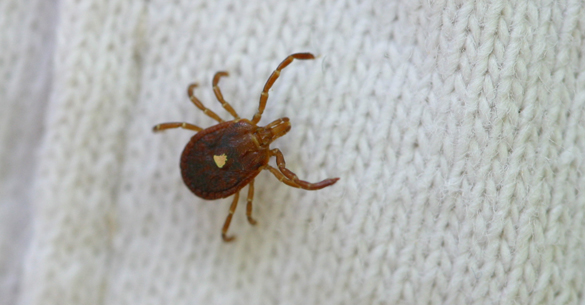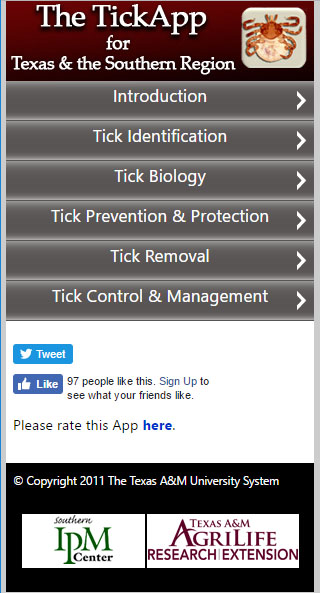
Lone star ticks are one of the most commonly encountered ticks outdoors in Texas. Female ticks are identified by the single white spot (lone star) in the middle of the dorsum.
Everyone who agrees with this statement, raise your hands. “The world would be a better place without ticks!”
Ha, just as I suspected! Everyone who has ever “gotten a tick” raised their hands. Everyone else has a blank look on their face.
For the uninitiated, ticks are eight-legged arachnids more closely related to spiders than insects. While all tick species feed on blood, some feed on wild animals and rarely bite people. Other ticks readily hitch rides on, and bite humans. Ticks are most commonly encountered in fields or wooded areas, especially along the edges between forest and open areas. They are generally not seen in urban sites (except brown dog ticks).
As ticks mature, their lives center around a series of hosts. Ticks typically feed on one host, then drop off to digest their blood meal, shed, and look for a new host. Species of greatest health concern in Texas are known as three-host ticks. This means that over the course of their lifetime they will feed on three (usually different) hosts. This habit of “feeding around” sets ticks up nicely as disease carriers. A tick that feeds on an animal with a disease can pick it up and transmit it to another host.
Tick-borne Diseases
The most common human diseases transmitted by Texas ticks include Rocky Mountain spotted fever, human erhlichiosis, and Lyme disease. Lyme disease is caused by a bacterial spirochete. Although present in Texas, Lyme disease is not as prevalent as in the north central and northeastern US. It is thought to be carried by the deer tick, Ixodes scapularis. Rocky Mountain spotted fever is a rickettsial bacteria disease, and is carried by both the dog tick, Dermacentor variabilis, and the lone star tick, Amblyomma americanum. It is potentially serious with a 20% fatality rate for people who go untreated. Ehrlichiosis is another bacterial disease, with less than 10 cases reported in Texas each year. It is less likely to have serious consequences than RMSF, but can still make you quite sick. Human ehrlichiosis in Texas is thought to be carried by the lone star tick.
Although symptoms vary somewhat among the different diseases, any time you know you’ve been bitten by a tick and come down afterwards with a rash or flu-like symptoms (aches, fever, headache), suspect the tick. If you or a family member find a tick attached to your skin, remove the tick right away. Instead of throwing it out, though, put it in a jar or Ziploc bag and label with the date and place you think it came from. If you later have a rash or flu-like symptoms, check with your doctor and be sure to bring your bagged sample. If after 4 weeks no unusual symptoms occur (most symptoms should occur within a few days to two weeks), you can toss the tick with an easy mind.
Currently the University of North Texas is accepting ticks removed for humans for testing. Follow the instructions on this site and send the living or dead tick along with a form. Samples may be sent in by any Texas resident, and results are usually available within a week.
Because each of these diseases is caused by a bacterium, they are treatable with antibiotics. Quick administration, however, is important. If there is a good chance of tick-borne disease, it is usually recommended that the doctor not wait for test results before starting treatment.
Self protection

The Tick App is a mobile-device friendly providing essential information for identifying and protecting yourself from ticks.
We may not be able to rid the world of ticks, but we can keep them from biting in the first place. The very useful Texas Tick App offers the following advice:
- Wear light-colored, full-length clothing whenever possible and cover your exposed skin with DEET repellent (30%).
- Tuck pant legs into socks to keep crawling ticks atop of clothing where they are visible.
- For additional protection, consider using repellents containing permethrin (e.g. Permanone®) for application to clothing, or purchase clothing that has been pre-treated with insecticide for protection against mosquitoes and ticks.
- Check yourself and your family for crawling or attached ticks. Look thoroughly on exposed skin, clothing and hair.
- When returning home, wash all outdoor clothing, sleeping bags and blankets in a hot water wash cycle. Otherwise seal your things inside a plastic garbage bag to kill any wandering ticks.
Side Note:
A recent press article has me answering media calls about ticks. The current interest stems seems to stem from a scary news story. The article focuses on super abundant ticks carrying a new disease. Unfortunately the story suffers from lack of context. Powassan Fever, the disease in the story, is not new. It has been known for almost 60 years. It is a relatively rare disease, with an average of 7 cases in the US annually. Also, Powassan fever, is restricted to the northern states and has never been found in Texas.
The story also predicts a bad tick season for 2017. But tick abundance varies greatly by region, and experts quoted for the story were from Cornell University in New York. A mild winter and moist spring in some areas may indeed set Texas up for above average tick numbers this year; but there’s no evidence of a tick invasion yet. So, don’t let ticks keep you indoors this summer, but don’t ignore them either.